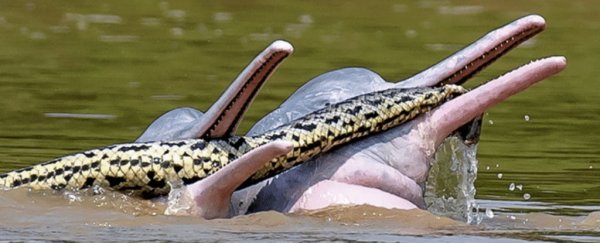The natural world around us is endlessly inspiring, and fascinating, and often very odd too: like when researchers snapped a photo of Bolivian river dolphins swimming around with a Beni anaconda snake in their mouths, for example.
These river dolphins are relatively rarely seen creatures, as it's unusual for them to have their heads above water for very long – let alone to be juggling a predatory snake between their jaws at the same time.
While it's not clear exactly what was going on here, dolphins and cetaceans more generally are well known for their playful activities, activities in which other animals might be involved, voluntarily or otherwise.
The photo was taken back in August 2021, near the Tijamuchi River in Bolivia. Researchers saw a group of dolphins staying above the water for longer than usual, but it was only after reviewing their pictures that they got a better idea of what was going on.
"After checking on the first images we realized that a snake was handled by [the dolphins], and while it was difficult to estimate their group size, there were at least six of them," the researchers write in a paper describing the observation.
"It became clear that they rather were playing with the snake than trying to eat it."
The dolphins interacted with the snake in a few different ways, occasionally swimming together in a synchronized way but mostly staying in the same area (the activity moved around 70-80 meters or 230-262 feet downstream while the researchers were watching over the course of 7 minutes).
These interactions between dolphins are rare, and It's possible that the dolphins were teaching each other about the snake, the researchers say, or perhaps eating it rather than playing with it. Another possibility is that the playful activity was actually sexual in nature.
"Afterwards, we were able to observe on the photographs that the adult males were sexually aroused while engaging in object play with the anaconda," write the researchers.
"There were juveniles on the scene as well, and it seemed that the adults were showing off the snake to them."
The Beni anaconda (Eunectes beniensis) can regularly grow up to 2 meters (6-and-a-half feet), and lives in the same part of the world as the Bolivian river dolphin (Inia geoffrensis boliviensis): namely the section of the Amazon rainforest in northeastern Bolivia.
River dolphins are typically difficult to observe – rivers tend to be muddier and harder to navigate than the oceans – so even if the details of what's going on aren't clear, this is still a useful insight into how these creatures spend some of their time (even more so considering that these dolphins are threatened with extinction).
Unfortunately, the likelihood is that the experience didn't end well for the snake. It didn't move during the interactions and stayed underwater for a long time, which makes the researchers think that it was probably dead by the end.
"I don't think that the snake had a very good time," one of the team, biologist Steffen Reichle from the Noel Kempff Mercado Natural History Museum in Bolivia, told the New York Times.
The research has been published in Ecology.
